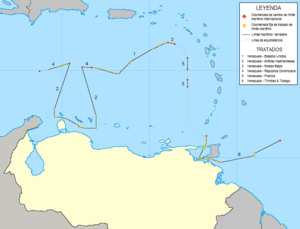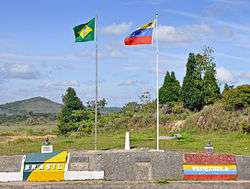Borders of Venezuela
The borders of Venezuela are the international borders that Venezuela shares with neighboring countries. Venezuela borders with 14 countries totaling 5,161 kilometers which includes territories of France (Martinique and Guadeloupe), the Kingdom of the Netherlands (Aruba, Curaçao and Bonaire), the United Kingdom (Montserrat) and the United States (Puerto Rico and the United States Virgin Islands). Venezuela has the seventh largest land and maritime border after France, China, the United Kingdom, Russia, the United States and Italy.
.svg.png)

Bordering countries
The lengths of the borders Venezuela shares with different countries, running counter-clockwise around Grenada to Caribbean Netherlands, are listed below:
| Country | Length (km) | Bordering Venezuelan states | Border features | Border crossings |
|---|---|---|---|---|
| 160 | Sucre | |||
| 11 | Sucre Delta Amacuro |
Gulf of Paria Bocas del Dragón |
Güiria | |
| 743 | Delta Amacuro Bolívar |
Guayana Esequiba Mount Roraima |
||
| 2,200 | Bolívar Amazonas |
Mount Roraima | Santa Elena de Uairen | |
| 2,219 | Amazonas Apure Táchira Zulia Falcón |
Táchira River Gulf of Venezuela Guajira Peninsula |
Simón Bolívar International Bridge | |
→includes: → → → |
65−80 | Falcón | ABC islands |
Total list
This is a list of countries and territories by land and maritime borders bordering Venezuela. The number and identity of other countries and territories that neighbor it are listed. Land borders and maritime boundaries are included and are tabulated separately and in combination. For purposes of this list, "maritime boundary" includes boundaries that are recognized by the United Nations Convention on the Law of the Sea, which includes boundaries of territorial waters, contiguous zones, and exclusive economic zones. However, it does not include lake or river boundaries, which are considered land boundaries.
Also included is the number of unique sovereign states[1] that a country or territory shares as neighbors. If the number is higher due to multiple dependencies or unrecognized states bordering the state, the larger number is shown in brackets.
Footnotes are provided to provide clarity regarding the status of certain countries and territories.
| Country or territory (Territories without full sovereignty[1] in italics) |
No. of land border neighbors[2] | No. of maritime boundary neighbors[2] | Total no. of unique neighbors[2] | Neighboring countries and territories (Territories without full sovereignty[1] in italics) (L) = share only land borders (M) = share only maritime boundaries blank = share land borders and maritime boundaries |
|---|---|---|---|---|
| 3 | 14 (17) | 15 (18) | ||
Gallery
 Flags of Brazil and Venezuela on the Brazil-Venezuela border in Pacaraima, Brazil.
Flags of Brazil and Venezuela on the Brazil-Venezuela border in Pacaraima, Brazil. Simón Bolívar International Bridge in Cúcuta, Colombia.
Simón Bolívar International Bridge in Cúcuta, Colombia. Tripoint between Brazil, Venezuela and Guyana located on Mount Roraima. Due to a border dispute between Venezuela and Guyana, Venezuela does not recognize this point as the tripoint.
Tripoint between Brazil, Venezuela and Guyana located on Mount Roraima. Due to a border dispute between Venezuela and Guyana, Venezuela does not recognize this point as the tripoint.
See also
References
- The concept of state sovereignty is somewhat imprecise and there are disagreements about whether certain territories are sovereign. There are currently 195 states that are generally regarded as "fully" sovereign: this includes the 193 member states of the United Nations plus the observer states of Vatican City and the State of Palestine. Some of these states have under their jurisdiction territories, dependencies, or collectivities that are clearly non-sovereign geographical areas. These territories are generally regarded as being subsumed within the overarching sovereignty of the governing state. For example, the United Kingdom holds sovereignty over the territory of Gibraltar, even though Gibraltar is not considered to be part of the United Kingdom. There are a few territories in the world that are neither clearly sovereign nor clearly subsumed under another state's sovereignty. Often, these territories have declared themselves to be sovereign, but they are either not widely recognized as such or lack some of the necessary conditions for sovereign statehood. In these cases, explanatory footnotes indicate how the territory is treated for the purposes of this list.
- A number in parentheses indicates the number of unique sovereign states that the country or territory shares as neighbors.
- Venezuela Disputes, IndexMundi
- Claims to territory overlap.
- This territory is not sovereign, but is a constituent country within the Kingdom of the Netherlands. For purposes of this list, Aruba, Curaçao, the Netherlands, and Sint Maarten are considered constituent parts of one sovereign state.
- This territory is not sovereign but is a British overseas territory. Its territory constitutes part of the sovereign territory of the United Kingdom but strictly speaking is not part of the United Kingdom itself.
- This territory is not sovereign, but is an insular area of the United States. U.S. territories are considered to be part of the sovereign territory of the United States.
.png)
